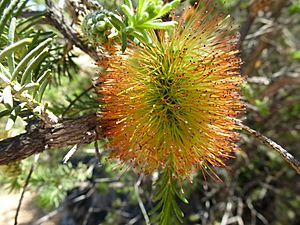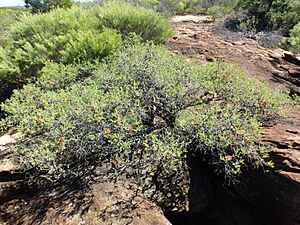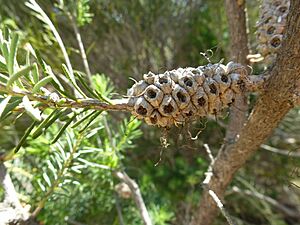Melaleuca calothamnoides facts for kids
Quick facts for kids Melaleuca calothamnoides |
|
|---|---|
 |
|
| M. calothamnoides flowers | |
| Scientific classification | |
| Genus: |
Melaleuca
|
| Species: |
calothamnoides
|
Melaleuca calothamnoides is a unique plant that belongs to the myrtle family, called Myrtaceae. It grows naturally only in a small part of Western Australia, near the coast. This plant is known for its pretty red and green flowers that look like spikes, and its soft leaves. Even though it's beautiful, it can be tricky to grow in home gardens.
Contents
What it Looks Like
Melaleuca calothamnoides is a bush that can grow between 1 to 4 meters (about 3 to 13 feet) tall. It can also spread out to about 1.5 meters (5 feet) wide. It has bark that feels rough.
Its leaves grow in an alternating pattern along the stem. They are about 7.5 to 13.5 millimeters (0.3 to 0.5 inches) long and 0.5 to 0.9 millimeters (about 0.02 to 0.04 inches) wide. The leaves are smooth (meaning they have no hairs), a bit fleshy, and shaped like a line. If you cut one, it would look almost round. The tip of each leaf is blunt and curved.
The flowers grow in cylinder-shaped spikes, which are about 40 to 50 millimeters (1.6 to 2 inches) long and wide. These spikes usually appear on older parts of the plant's branches. Each spike can have 40 to 60 flowers. The stamens (the parts that make pollen) are grouped into five bundles around the flowers. Each bundle has 4 to 5 stamens. They are usually green in the middle and turn red at their tips. This plant flowers for a long time, from July to October.
After flowering, the plant produces woody capsules (seed pods) that are also in dense spikes. These spikes are 40 to 50 millimeters (1.6 to 2 inches) long along the stem. Each capsule is about 4 to 5 millimeters (0.16 to 0.2 inches) long and wide.

Plant Name and History
The plant Melaleuca calothamnoides was officially named in 1862 by a scientist named Ferdinand von Mueller. He described it in his book Fragmenta Phytographiae Australiae. He found a sample of the plant growing in limestone hills near the Murchison River, thanks to Augustus Oldfield.
The second part of its name, calothamnoides, tells us something interesting. It means that this plant looks similar to another type of plant in the genus called Calothamnus. The ending -oides is a Latin suffix that means "resembling" or "looking like."
Where it Grows
This type of melaleuca plant is found in the area around the Murchison River in Western Australia. This specific area is known as the Geraldton Sandplains biogeographic region, which is a way to describe areas with similar plants, animals, and environments. Even though it only grows in a small part of Australia, it is quite common in that specific area, especially in dry gullies and creek beds.
Is it Endangered?
The Government of Western Australia's Department of Parks and Wildlife has looked at Melaleuca calothamnoides. They have listed it as "not threatened," which means it is not currently in danger of disappearing.
Growing it in Gardens
This shrub is very attractive because of its red and green flowers and its soft leaves. However, it can be quite hard to grow in a garden. You can start new plants from seeds or from cuttings (small pieces of the plant). But for it to grow well, it needs soil that drains water easily and is acidic.



